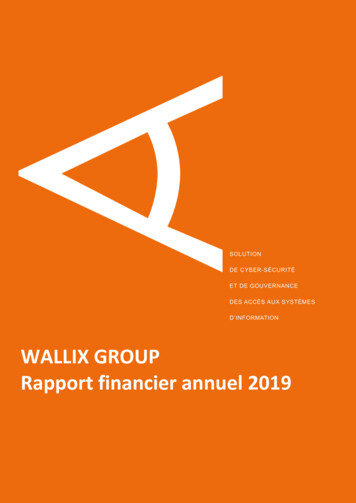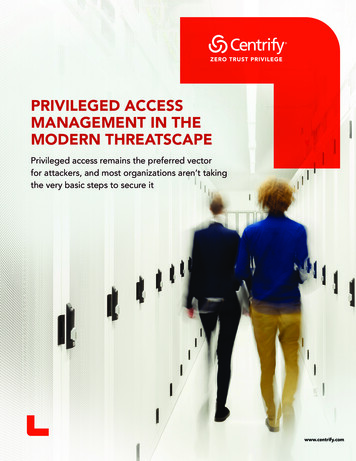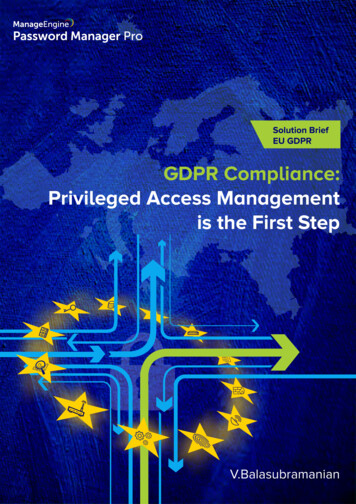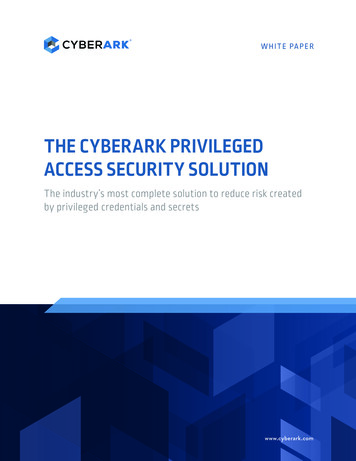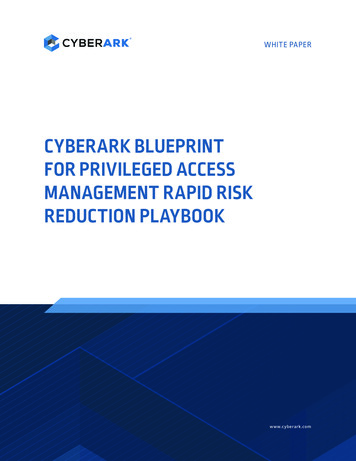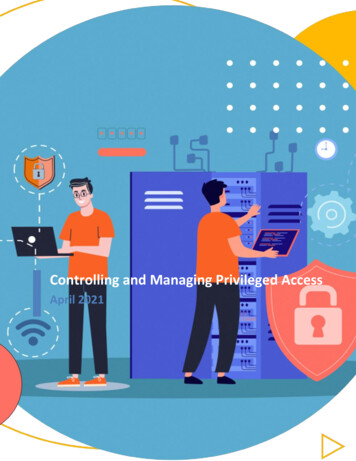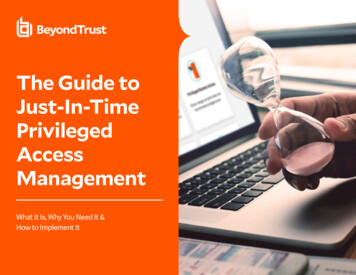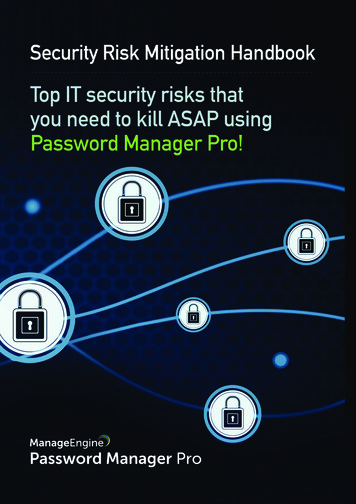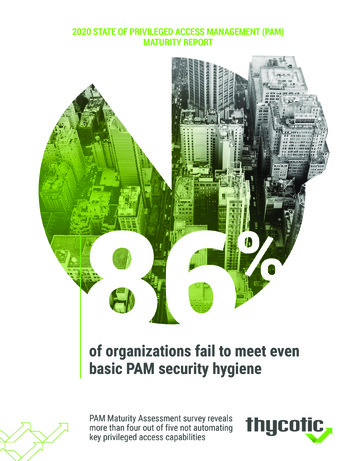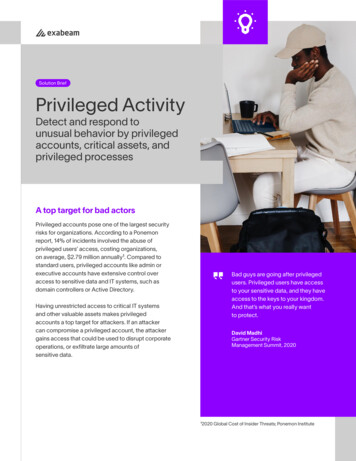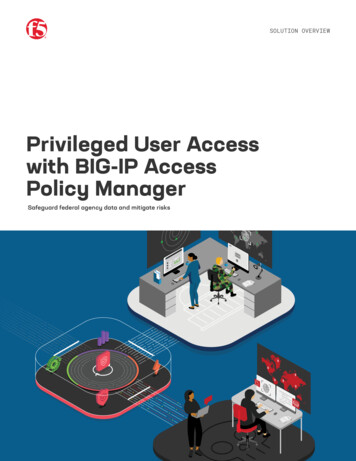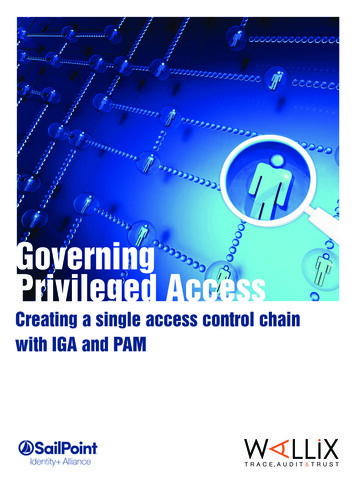
Transcription
GoverningPrivileged AccessCreating a single access control chainwith IGA and PAM
Governing Privileged Access: Creating a single access control chain with IGA and PAMGoverning Privileged Access:Creating a single access control chainwith IGA and PAMABSTRACTThe steady drumbeat of highly damaging corporate data breaches along with the increasingly stringentcompliance demands legislated in their response means organizations need a way for controlling allaccess, including privileged, to IT resources more so than ever before. Trends like cloud computing,growth in mobile device use, and a general increase in the threat landscape including the failure ofperimeter based security solutions has created urgent pressure to make identity-based security controlseven more robust. Many organizations employ specialized Identity Governance & Administration (IGA)systems for this purpose, which also include other beneficial base functionality like providing data foraudits of system access. What identity governance solutions don’t do is monitor privileged access. PAMcontrols that kind of access by system administrators who have privileges such as modifyingconfiguration, adding and deleting accounts, and so forth. The truth is out of necessity and legislationboth arise a need for system access to be monitored and controlled at every level. Joint IGA-PAMsolutions can create a single access control chain by combining the range of identity governance withthe specificity and power of inspection of PAM solutions. This paper examines how adding PAM “deepcontrols” like credential vaulting and rotating to the power of identity governance each serves to extendthe potential and value of the other and offers insights into how these two technologies can worktogether to bolster overall security and compliance.INTRODUCTIONIdentity is elemental to information security and compliance. Who is who in the organization? Who is allowedto do what? Security and compliance managers need to define and enforce access policies based onidentity. Mr. X can use System A, but not System B. Ms. Y can use Systems A and B, and so forth.Identity governance grows more challenging as organizations expand into ever more complex digitalenterprises. A new generation of sophisticated Identity Governance & Administration (IGA) solutions offerenterprises a method of meeting increasing security and compliance challenges. While managing useridentity, however, the organization must also monitor the parallel process of Privileged AccessManagement (PAM). PAM involves controlling and monitoring access by those who have administrativeprivileges. Both identity governance and PAM are necessary today, ideally working together. This paperlooks at how a joint IGA-PAM solution can work.
Governing Privileged Access: Creating a single access control chain with IGA and PAMIGA OVERVIEWIf you’ve ever been asked for a username and password in order to log into a site, you’ve used a simpleidentity management system. Things can get complicated fast, though. Consider how manyapplications and user types you might have in a large organization. If you’re responsible for security orcompliance, how can you be sure that only authorized people have access to IT resources?IGA should ideally govern access to any and every IT resource. These include applications, databases,storage resources and networks, as well as resources belonging to partners. IGA’s job is to mitigate thesecurity and compliance risks inherent in unauthorized access, and protect organizations from datatheft, disclosure of confidential information and malicious mischief, among other things.To defend against these risks, IGA systems generally employ certain core functionality: Approvals – governance and management of user identity, access and service requestsacross the entire identity life cycle. Auditing – providing auditing and governance data to enable organizations to meetcompliance requirements. Policy Checking – automatic, policy-based access in accordance with employee events,including joining, moving or leaving the organization. Access Reviews – auditing of usage rights for security and compliance.There are a number of approaches to implementing identity governance. In some cases, access andidentity are governed on a system-by-system basis, while in others each type of access is matched toa specific role. For example, an accounting user can access the accounting system, but not the humanresources applications. A business might have access and identity governed at the level of the businessunit. Employees of division X can access a set of systems. Employees in division Y cannot, and so forth.PAM OVERVIEWPAM governs privileged access. A privileged account has administrative access to the “back end” ofthe IT resources that everyone else uses. While IGA and PAM slightly overlap, they are also markedlydifferent. A privileged user is able to set up, modify, or delete IT resources. This is sometimes called “rootaccess,” which can potentially be dangerous. Through error or malfeasance, a privileged user with rootaccess can wreak havoc on an organization’s information assets.A PAM solution seeks to mitigate the risk of unauthorized privileged access or privilege escalation. It
Governing Privileged Access: Creating a single access control chain with IGA and PAMaccomplishes this goal by establishing a secure, streamlined way to authorize and monitor all privileged users: Granting privileges to users only for systems on which they are authorized. Granting access only when it’s needed and revoking it based on time and other factors.This is important given that privileged access is often granted to external parties such asIT contractors and vendors. There is no reason for any privileged user to have privilegedaccess after the specific purpose of that access has been served. Avoiding the need for privileged users to have or need local/direct system passwords.Direct access to systems frequently means that the privileged user can circumvent the PAMsolution. In this case, there is no control nor is it likely that the privileged session is beingmonitored for a change log and audit trail. This is a huge risk. Centrally and quickly managing access over a disparate set of heterogeneous systems. Creating an unalterable audit trail for any privileged operation.Privileged Access Management architectures vary, but most have the following components working together:- An Access Manager, which controls privileged account access. This is a single point ofpolicy definition and policy enforcement for privileged access management. The AccessManager knows which systems the user can access and at what level of privilege.- A Password Vault, which uses single sign-on (SSO) and comparable techniques whichprevent privileged users from knowing the actual passwords to critical systems. Userscannot view or access their passwords to targeted systems. This prevents manualoverriding of a system on a physical device.- A Session Manager, which tracks what a privileged user actually did during anadministrative session.UNDERSTANDING THE MANDATE FOR BETTER IDENTITY GOVERNANCESecurity and compliance drive improvements in the efficacy of identity governance. This affects bothIGA and PAM. Security threats have multiplied in recent years. Business impacts from security incidentshave grown more serious, as well. Increasingly virulent threats are posed by cyber warfare, hackersrepresenting sovereign states, organized criminal gangs, and more. Internal threats also abound.In each case, identity governance and access control are essential to defend against attacks. Attackersfrequently try to gain root access by posing as someone within the organization. They may start outposing as a standard user and get upgraded to privileged status. They might create a nonexistent user
Governing Privileged Access: Creating a single access control chain with IGA and PAMwith special access rights. Or, they will attack directly by assuming root access. In any case, once theyhave root privileges, the attacker can exfiltrate data, bring systems down, cause embarrassment, andso forth. Indeed, some of the worst data breaches in recent history have involved malicious actorsassuming privileged yet unauthorized roles in order to breach protected systems.Compliance involves identity governance and PAM along multiple threads. The Governance, Risk andCompliance (GRC) frameworks used by most organizations invariably cover identity governance. Thereason for this has to do with a basic, but sometimes overlooked aspect of compliance: while theorganization is bound by regulations, it is the people who actually do the tasks that make theorganization compliant. Therefore, people must be subject to controls that ensure compliance. Thisobjective is realized through IGA and PAM. The following examples demonstrate the intersectionbetween IGA, PAM, and compliance: PCI – Payment card processing requires many information controls, such as data encryption.Encryption, though, is not a technological abstraction. Someone has to set up the encryptionfunctionality. Someone can modify it or override it. A PCI compliant organization must thereforebe able to prove that the people responsible for encryption are properly verified and undereffective identity governance. The organization has to ensure that no unauthorized person isdisrupting the encryption required to stay compliant. More broadly, PCI compliance meansimplementing identity-based access controls to limit access to card data to only those employeeswho require it. The organization also needs to be able to control visibility into card transactionsand audit identity-based access logs. This takes an integrated IGA and PAM solution. SOX – Sarbanes-Oxley requires a review and audit of internal controls that affect financialreporting. Many internal controls are specifically directed at individual system users. For instance,“segregation of duties” may be needed to make sure that a control is effective. Segregation ofduties is a mode of control that splits up tasks that can affect a company’s finances betweenmultiple users so that no one user can defraud the business. As an example, segregation of dutiesmight state that a single user may not both create a user and pay a user. An IGA solution candefine and enforce this kind of segregation of duties. PAM is needed to make sure that anaccounting user cannot override the segregation of duties setup. The financial industry has seenjust this kind of problem firsthand. At least one massive banking scandal arose when a bankemployee was able to override a trading system by impersonating his manager. Separate controlscan work together to mitigate fraud risk. PAM vaults passwords and records sessions to make sureeach system is hard to abuse. IGA keeps track of who has access to what and prevents toxiccombinations of access via segregation of duty policies, while keeping access fresh and fitted toreflect changing roles as people change jobs. HIPAA – Guaranteeing the privacy of personal health information means controlling the peoplewho use it. Identity governance solution provision and deprovision access to electronic healthrecords (EHRs). PAM is responsible for protecting root access to systems that store EHRs.
Governing Privileged Access: Creating a single access control chain with IGA and PAMDRIVERS OF INCREASINGLY ROBUST IDENTITY MANAGEMENTNew developments in technology and business exert added pressure on organizations to improveidentity governance. Cloud computing, for instance, requires that organizations control access in multipleinfrastructure environments, some of which they may not manage directly. Other examples include: Mobility – The growing use of mobile devices for work, including “Bring Your Own Device”(BYOD) policies, opens up a number of issues for IGA and PAM. Authenticating users of devicesnot controlled by the organization means extending identity governance onto new platforms. Newsecurity use cases arise, as well. What happens if an employee loses his or her personal mobiledevice, which happens to include access to protected systems? IGA policy and technology mustaddress this scenario, among many other security and compliance implications of BYOD policies. Alliances and partnerships between organizations – Boundaries between users in differentorganizations have grown blurrier in recent years. Think about how users at a healthcare insurerand a hospital may need access to the same patient information. How can IGA and PAM controlwho sees what? Who decides that a user needs to be cut off from access? Multiple classes of workers – IGA and PAM must contend with many different types of users.Today, organizations have contractors, vendor employees, visitors, and temporary staff who needaccess to IT resources. Each type or user will likely need his or her own class of access withspecific time structures. A guest may need a day-long access to a certain network. A contractormay need 90-day access to a single application.THE RISKS OF IDENTITY GOVERNANCE SILOSIGA and PAM complement one another, but when they are implemented separately there can be silosof identity governance. This creates problems for security and compliance and threatens both viamaintenance of inconsistent access policies. For example, privileged access may not be subject toreviews established by IGA. A system admin may thus be able to inappropriately access confidentialdata or restricted processes. Segregation of duties mandated by compliance may easily becompromised in this setting.Sound identity governance calls for line of business (LOB) involvement in managing access rights. LOBinvolvement is important because it provides the proper business context to determine who shouldhave access to what. When there are seperate identity silos, their contribution becomes harder toimplement simply because the LOB may have no awareness of what privileged access rights exist.IGA forces access approvals to become part of the ongoing business process, which is particularlyimportant when governing privileged accounts. Without IGA, it is hard to properly scale administrationof these accounts, leaving IT in a challenging position.
Governing Privileged Access: Creating a single access control chain with IGA and PAMNon-employee access presents another risk. Building on the theme mentioned above, the businessneeds to address the reality that many privileged users work for someone else. Businesses’ mostconfidential IT resources may routinely be accessible to external IT consultants, freelance softwaredevelopers, outsourced workers in other countries, vendor technical reps, and more. They may be themost ethical people in the world, but the business won’t know who they are and what they are doing.That’s a big risk exposure.Consider the following segregation of duties example: imagine that John is a procurement staffer. As auser of the procurement management system, he can approve purchase orders but he does not have theauthority to approve new vendors. That duty is segregated based on policies defined and enforced throughan identity governance solution. Only John’s manager, Julie, can approve new vendors. This segregationenforces an internal control that prevents a single person from setting up a new vendor and approving apurchase order to that vendor. Without this control, the company is exposed to internal fraud risk.Now, imagine that John requests privileged access through a PAM solution so he can modify thesettings on the procurement system. The IT person responsible for the procurement system manuallyapproves the request, figuring that John has a legitimate reason to access the back end. Julie is notaware that John requested back end access. She doesn’t know that he’s been granted access and shehas no idea what modifications he’s made to the system.This is an internal control failure. Even if nothing bad happens, the lack of visibility and traceabilityrepresents a control deficiency. It might get picked up on audit, but it could easily get missed. Beyondcompliance issues, the lack of LOB visibility and general oversight into privileged access exposes thecompany to risks of data theft and more.THE VISION: A SINGLE IDENTITY GOVERNANCE POLICYThe security and compliance environment calls for a single identity governance policy that includesprivileged access management. If this vision can be realized, then a request for privileged access canbe managed in accordance with established identity governance policies. This way, all access requestsand grants are part of a single access control chain. All access becomes more easily auditable.Creating a single access control chainGiven that IGA and PAM systems are usually separate, with separate ways of modeling identity andcontrolling access, how can there be a single access control chain? The answer involves leveraging ajoint IGA and PAM solution that centralizes identity governance to include privileged access managementwith a single, authoritative identity store. The IGA system can now be set up with automated workflowsthat require manager approval of any access requests, including requests for privileged access.Returning to the example, what if John changes departments? A joint IGA-PAM solution can flag the fact
Governing Privileged Access: Creating a single access control chain with IGA and PAMthat John should not have his old procurement system access privileges if he is no longer working inprocurement. If he is able to retain his admin rights to the procurement system even if he leaves thedepartment, the internal control will be deficient. When John requests privileged access to theprocurement system through the PAM solution, his transfer will trigger a review and approval of hisaccess privileges by Julie. She may or may not approve the request, but she will at least be aware of itand can flag any segregation of duty violations. Alternatively, the IGA system could establish accessapproval rules that deny privileged access requests that violate segregation of duties or other accessgovernance policies. The rules contained in the request approval workflow can be shaped byidentity governance policies.Changes to John’s access privilegesJohn’s PAM approval request can tell Julie whether John is a full time employee or a contractor, andso forth. The requests and grants of access are recorded on a central audit log. If Julie approves John’srequest, the PAM solution will then log any of his privileged account sessions, something that mostIGA solutions are not set up to do.Architecturally, a joint IGA-PAM solution could be integrated in several different ways. Most industryexperts favor an approach that bases PAM functions on a central identity store managed by the IGAsolution. With this approach, there is just one master set of identities to manage for both general accessand privileged access. The IGA solution can also house a comprehensive audit log of all accessrequests, including privileged access requests.BENEFITS OF THE JOINT IGA-PAM SOLUTIONDone right, a joint IGA-PAM solution protects a company’s most critical data and IT assets better thanhaving separate IGA and PAM identity silos. It improves the overall GRC posture.Benefits include: Having a single point of control and access control chain for provisioning all access in the organization. Ensuring that privileged access sessions are performed in accordance with an organization’sgovernance policy. Enabling auditors to more easily discover inconsistencies in access authorizations, includingsegregation of duties violations and other role-based access restrictions. Identifying users with excessive access to highlight potential insider risks. Streamlining the process of on-boarding and off-boarding of all users, both internal and external.
Governing Privileged Access: Creating a single access control chain with IGA and PAMCONCLUSIONIdentity governance is one of the few things that security and compliance managers can count on to bothcombat the changing and dangerous threat landscape and meet growing compliance demands. Themost serious security threats now involve manipulation of identity. IGA solutions offer a way to governwho has access to what, but they generally lack deep the deep controls – such as credential vaultingand session recording – that are needed to increase the security of privileged accounts. A PAM solutionoffers a secure, streamlined way to authorize and monitor all privileged users for all relevant systems. Ajoint IGA-PAM solution can mitigate identity governance risks better than either IGA or PAM on its ownby extending the reach of traditional identify governance and preventing breaches associated withprivileged access. IGA and PAM vendors are now collaborating closely on joint solutions for full identitygovernance that create a single access control chain capable of monitoring and controlling systemaccess at every level. This not only dramatically improves security, but also means access becomesmore easily auditable, enhancing an organization’s ability to meet its compliance challenges.
OFFICES &LOCAL REPRESENTATIONSWALLIX FRANCE (HQ)http://www.wallix.com/frEmail : sales@wallix.comWALLIX Group is a cybersecurity software vendor dedicated to defendingand fostering organizations’ success and renown against the cyberthreatsthey are facing. For over a decade, WALLIX has strived to protectcompanies, public organizations, as well as service providers’ mostcritical IT and strategic assets against data breaches, making it theEuropean expert in Privileged Access Management.250 bis, rue du Faubourg Saint-Honoré75017 Paris - FRANCETél. : 33 (0)1 53 42 12 90Fax : 33 (0)1 43 87 68 38WALLIX UKhttp://www.wallix.co.ukEmail: ukinfo@wallix.comAs digitalization impacts companies’ IT security and data integrity worldwide,it poses an even greater challenge if the data involved is highly sensitive. Therecent regulatory changes in Europe (NIS/GDPR) and in the United States(NERC CIP/Cyber Security Directorate) urge companies belonging to sensitivesectors to place cybersecurity at the heart of their activity.1 Farnham Rd, Guildford, Surrey,GU2 4RG,UKOffice: 44 (0)1483 549 944In response to these challenges, WALLIX created a bastion designed tosecure organizations’ core assets while adapting to their daily operationalduties: WALLIX ADMINBASTION Suite. The WALLIX bastion accompaniesmore than 100 operators in sensitive sectors to conform with regulationsand over 400 organizations in the protection of their critical assets,securing the access to more than 100,000 resources throughout Europeand the MEA region. It was also the first government-certified solution inthe market.Landsberger Str. 39881241 MünchenPhone: 49 89 716771910WALLIX partners with a trained and certified network of over 90 resellersand distributors that help guarantee effective deployment and user adoption.WALLIX is the first European cybersecurity software editor to be publiclytraded and can be found on EuroNext under the code ALLIX. As one of theleaders of the PAM market, major players trust WALLIX to secure accessto their data: Danagas, Dassault Aviation, Gulf Air, Maroc Telecom,McDonald’s, and Michelin are among them.WALLIX is the founding member of Hexatrust. The WALLIX bastion waselected “Best Buy” by SC Magazine and awarded at the 2016 ComputingSecurity Awards, BPI Excellence, and Pôle Systematic.WALLIX DEUTSCHLANDhttp://www.wallix.deEmail: deinfo@wallix.comWALLIX USA (HQ)http://www.wallix.comEmail: usinfo@wallix.comWorld Financial District, 60 Broad StreetSuite 3502, New York, NY 10004 - USAPhone: 1 781-569-6634WALLIX RUSSIA & CIShttp://www.wallix.com/ruEmail: wallix@it-bastion.comООО «ИТ БАСТИОН»107023, Россия, Москва,ул. Большая Семеновская, 45Тел.: 7 (495) 225-48-10WALLIX ASIA PACIFIC(Bizsecure Asia Pacific Pte Ltd)Email: contact@bizsecure-apac.com8 Ubi Road 2, Zervex 07-10Singapore 408538Tel: 65-6333 9077 - Fax: 65-6339 8836Twitter: @wallixcomWALLIX AFRICAwww.wallix.comSYSCAS (Systems Cabling & Security)Email: sales@wallix.comAngré 7ème Tranche Cocody06 BP 2517 Abidjan 06CÔTE D'IVOIRETél. : ( 225) 22 50 81 90
Creating an unalterable audit trail for any privileged operation. Privileged Access Management architectures vary, but most have the following components working together: - An Access Manager, which controls privileged account access. This is a single point of policy definition and policy enforcement for privileged access management. The Access
